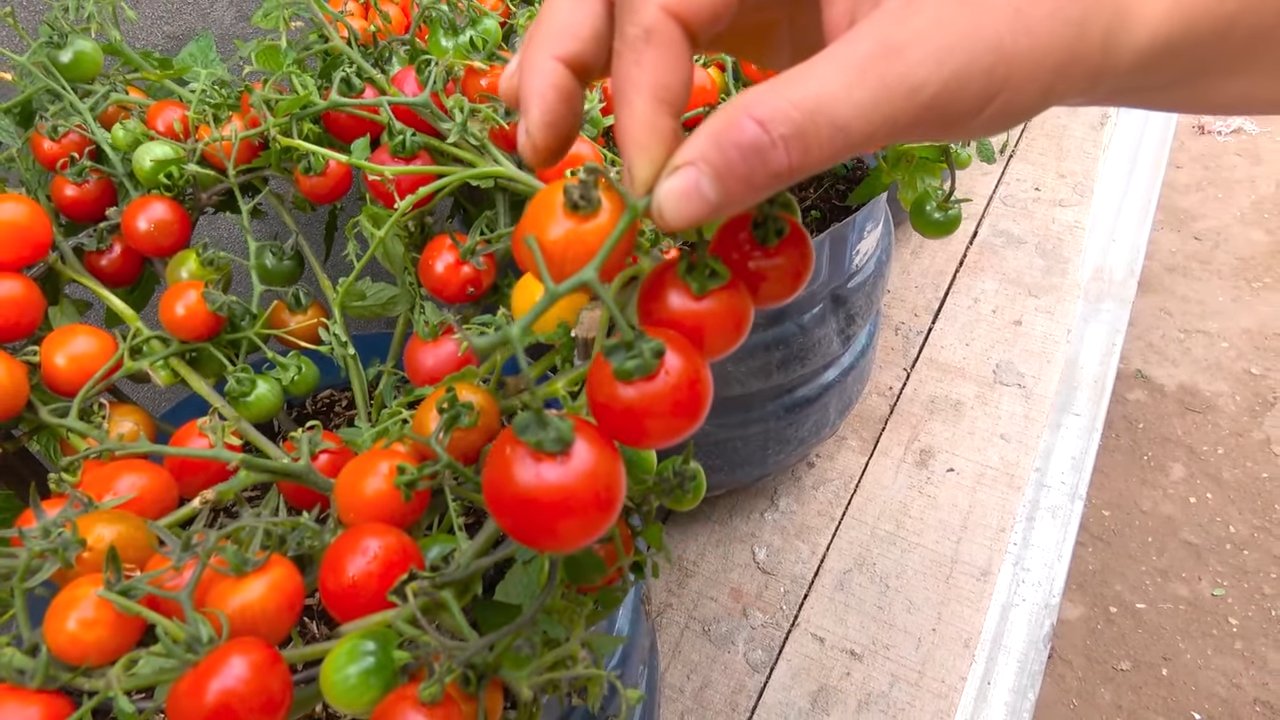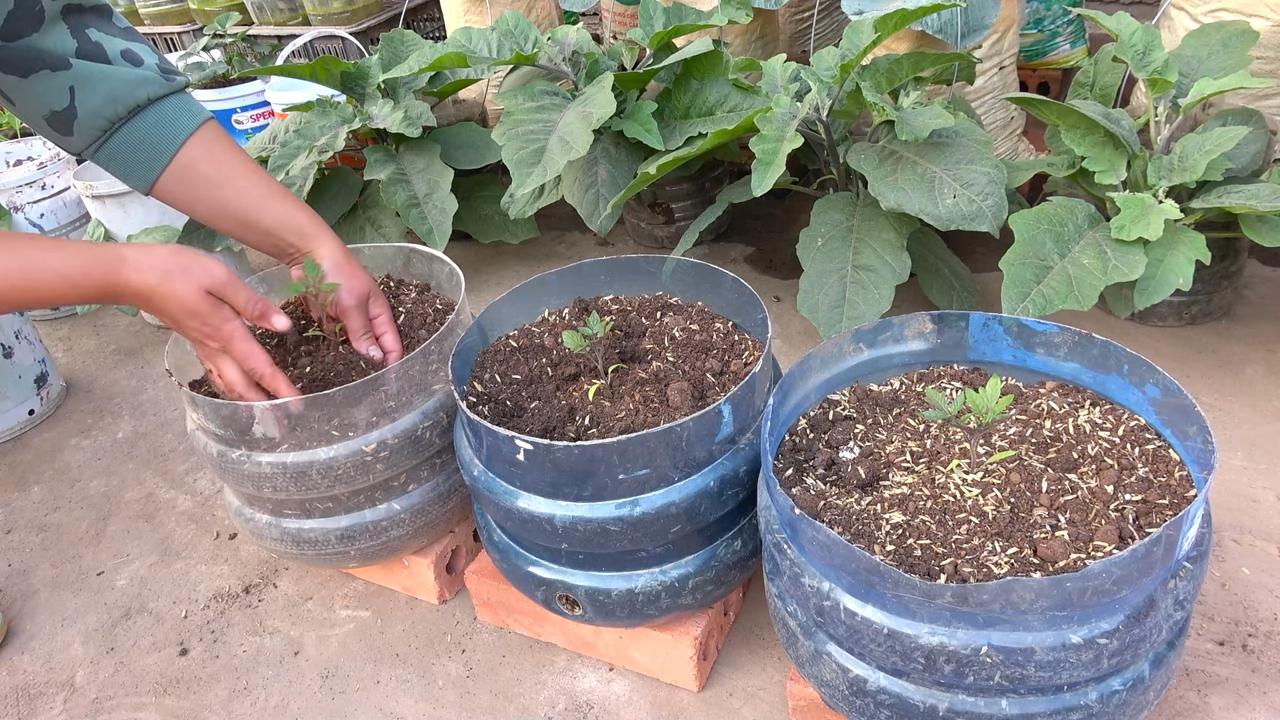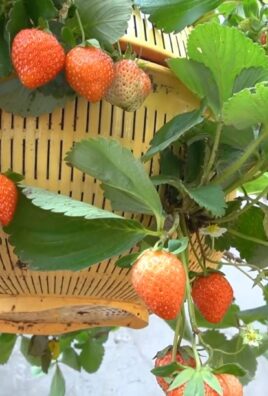Grow Sweet Cherry Tomatoes like a pro, even if you think you have a “brown thumb”! Have you ever dreamed of plucking juicy, sun-ripened cherry tomatoes straight from your own backyard, bursting with flavor that store-bought ones just can’t match? I know I have! This isn’t just about gardening; it’s about creating a little slice of summer right outside your door.
The humble cherry tomato, believed to have originated in South America, has become a global culinary staple. From simple salads to gourmet dishes, these little bursts of sweetness add a touch of sunshine to any meal. But beyond their deliciousness, growing your own cherry tomatoes connects you to a tradition of self-sufficiency and fresh, healthy eating that stretches back centuries.
So, why should you dive into this DIY adventure? Well, for starters, you’ll save money! Those little containers of cherry tomatoes at the grocery store can be surprisingly pricey. More importantly, you’ll know exactly what’s going into your food – no mystery pesticides or artificial ripening. Plus, there’s something incredibly satisfying about nurturing a plant from seed to harvest. I’m going to share some simple, yet effective, home gardening tricks and DIY hacks that will help you grow sweet cherry tomatoes that are the envy of the neighborhood. Get ready to roll up your sleeves and get your hands dirty – let’s get growing!

Growing Sweet Cherry Tomatoes: A DIY Guide to Bountiful Harvests
Hey there, fellow gardening enthusiasts! I’m so excited to share my secrets for growing the sweetest, most delicious cherry tomatoes you’ve ever tasted. Forget those bland, store-bought ones – we’re talking bursting-with-flavor, sun-ripened goodness right from your own backyard (or balcony!). This guide will walk you through every step, from seed to salsa, ensuring you have a thriving cherry tomato plant that keeps on giving.
Choosing the Right Cherry Tomato Variety
Before we even get our hands dirty, let’s talk varieties. Not all cherry tomatoes are created equal! Some are sweeter, some are more disease-resistant, and some are better suited for container gardening. Here are a few of my personal favorites:
* Sungold: These are my absolute go-to! They’re incredibly sweet, almost like candy, and have a beautiful golden-orange color. They are prone to cracking, so consistent watering is key.
* Sweet Million: As the name suggests, these produce a massive amount of small, sweet, red cherry tomatoes. They’re very prolific and relatively easy to grow.
* Black Cherry: For something a little different, try Black Cherry. They have a rich, complex flavor with a hint of smokiness.
* Juliet: These are technically grape tomatoes, but they’re so similar to cherry tomatoes that I’m including them. They’re elongated, firm, and have a great, slightly tangy flavor. They are also very disease resistant.
* Gardener’s Delight: A classic for a reason! These are reliable, flavorful, and produce well in a variety of conditions.
Consider your climate, space, and taste preferences when choosing your variety. Read seed descriptions carefully!
Starting Your Cherry Tomato Seeds (or Buying Seedlings)
You have two options here: starting your own seeds indoors or buying seedlings from a nursery. Starting from seed gives you more control over the variety and can be more cost-effective, but it requires a little more effort.
Starting Seeds Indoors (Recommended for Early Harvests)
This is how I get a head start on the growing season!
1. Gather Your Supplies: You’ll need:
* Cherry tomato seeds (of course!)
* Seed starting trays or small pots (I like using peat pots or biodegradable pots to minimize transplant shock)
* Seed starting mix (this is different from regular potting soil – it’s lighter and better for delicate seedlings)
* A spray bottle filled with water
* A heat mat (optional, but it speeds up germination)
* A grow light (also optional, but it prevents leggy seedlings)
2. Sow the Seeds: Moisten the seed starting mix and fill your trays or pots. Sow 2-3 seeds per cell or pot, about ¼ inch deep. Gently cover the seeds with more mix.
3. Water and Warmth: Lightly mist the soil with the spray bottle. Place the trays or pots on a heat mat (if using) and cover them with a clear plastic dome or plastic wrap to create a humid environment.
4. Germination: Keep the soil consistently moist but not soggy. The seeds should germinate in 5-10 days. Once they sprout, remove the plastic dome or wrap and place the trays under a grow light or in a sunny window.
5. Thinning: Once the seedlings have their first true leaves (the second set of leaves that appear after the initial seed leaves), thin them to one seedling per cell or pot. Choose the strongest, healthiest-looking seedling and snip off the others at the soil line.
6. Hardening Off: About a week before you plan to transplant the seedlings outdoors, you need to “harden them off.” This means gradually exposing them to outdoor conditions to acclimate them. Start by placing them outside for an hour or two each day in a sheltered spot, gradually increasing the time each day.
Buying Seedlings
If you don’t have the time or space to start your own seeds, buying seedlings is a perfectly fine option! Just make sure to choose healthy-looking plants with sturdy stems and no signs of disease or pests.
Preparing Your Garden Bed or Containers
Cherry tomatoes need plenty of sunshine and well-drained soil.
1. Sunlight: Choose a location that gets at least 6-8 hours of direct sunlight per day. This is crucial for sweet, flavorful tomatoes.
2. Soil: Cherry tomatoes prefer slightly acidic soil with a pH of 6.0-6.8. Amend your soil with compost or other organic matter to improve drainage and fertility. If you’re growing in containers, use a high-quality potting mix.
3. Container Size: If you’re growing in containers, choose pots that are at least 12 inches in diameter and depth. Larger containers are better, as they provide more room for the roots to grow. I prefer 5-gallon buckets or larger.
4. Support: Cherry tomato plants can get quite large and sprawling, so they need support. You can use stakes, cages, or trellises. I personally prefer cages, as they provide all-around support. Install the support system *before* you plant your seedlings to avoid damaging the roots later.
Transplanting Your Cherry Tomato Seedlings
Now for the fun part!
1. Timing: Wait until the danger of frost has passed before transplanting your seedlings outdoors. Cherry tomatoes are very sensitive to frost.
2. Preparation: Water your seedlings well before transplanting. Dig a hole that is slightly larger than the root ball of the seedling.
3. Planting: Gently remove the seedling from its pot, being careful not to damage the roots. Place the seedling in the hole and backfill with soil. Plant the seedling deep, burying the stem up to the first set of leaves. This will encourage the plant to develop more roots along the buried stem, resulting in a stronger, healthier plant.
4. Watering: Water the newly transplanted seedlings thoroughly.
5. Mulching: Apply a layer of mulch around the base of the plants to help retain moisture, suppress weeds, and regulate soil temperature. I like using straw or shredded leaves.
Caring for Your Cherry Tomato Plants
Consistent care is key to a bountiful harvest.
1. Watering: Water your cherry tomato plants deeply and regularly, especially during hot, dry weather. Aim to water at the base of the plant to avoid wetting the foliage, which can lead to disease. A good rule of thumb is to water when the top inch of soil feels dry to the touch.
2. Fertilizing: Cherry tomatoes are heavy feeders, so they need regular fertilization. Use a balanced fertilizer (e.g., 10-10-10) or a tomato-specific fertilizer. Follow the instructions on the fertilizer package. I like to fertilize every 2-3 weeks. You can also use compost tea as a natural fertilizer.
3. Pruning: Pruning can help improve air circulation and encourage fruit production. Remove suckers (the small shoots that grow between the main stem and the branches) to direct the plant’s energy towards fruit production. I usually prune the lower leaves as well to prevent soil-borne diseases from splashing onto the foliage.
4. Pest and Disease Control: Keep an eye out for pests and diseases. Common pests include aphids, tomato hornworms, and whiteflies. Common diseases include early blight, late blight, and blossom end rot. Use organic pest control methods whenever possible, such as insecticidal soap or neem oil. For diseases, remove infected leaves and improve air circulation. Blossom end rot is caused by a calcium deficiency, so make sure your soil has enough calcium or add calcium supplements.
5. Support Maintenance: As your plants grow, make sure they are adequately supported by their stakes, cages, or trellises. Tie up any stray branches to prevent them from breaking under the weight of the fruit.
Harvesting Your Sweet Cherry Tomatoes
This is the moment we’ve been waiting for!
1. Ripeness: Cherry tomatoes are ready to harvest when they are fully colored and slightly soft to the touch. They should easily detach from the vine.
2. Harvesting Technique: Gently twist or snip the tomatoes from the vine.
3. Storage: Store your cherry tomatoes at room temperature for the best flavor. They will keep for a few days. If you need to store them for longer, you can refrigerate them, but they will lose some of their flavor.
4. Enjoy! Eat them fresh, add them to salads, roast them, or make a delicious cherry tomato sauce. The possibilities are endless!
Troubleshooting Common Cherry Tomato Problems
Even with the best care, you might encounter some problems along the way. Here are a few common issues and how to address them:
* Blossom End Rot: This is a common problem that causes the bottom of the tomatoes to turn black and leathery. It’s caused by a

Conclusion
So, there you have it! Growing sweet cherry tomatoes at home is not only achievable, but it’s also incredibly rewarding. Forget those bland, store-bought tomatoes that lack that burst of sunshine flavor. With a little effort and this simple DIY trick, you can cultivate your own miniature garden of deliciousness, ready to be plucked and enjoyed straight from the vine.
Why is this a must-try? Because the difference in taste between a commercially grown cherry tomato and one you’ve nurtured yourself is simply astounding. You control the growing conditions, ensuring optimal sunlight, watering, and nutrient levels, resulting in a sweeter, juicier, and more flavorful fruit. Plus, there’s immense satisfaction in knowing you’ve grown something yourself, from seed to table.
But the benefits don’t stop there. Growing your own cherry tomatoes is also a fantastic way to reduce your carbon footprint. You’re cutting down on transportation costs and packaging waste, making it a more sustainable choice. And let’s not forget the cost savings! Over time, growing your own tomatoes can significantly reduce your grocery bill.
Ready to take it to the next level? Consider these variations:
* Experiment with different varieties: While we’ve focused on sweet cherry tomatoes, there’s a whole world of heirloom varieties to explore. Try ‘Sungold’ for an exceptionally sweet, golden-orange tomato, or ‘Black Cherry’ for a rich, smoky flavor.
* Vertical gardening: If you’re short on space, consider growing your cherry tomatoes in hanging baskets or vertical planters. This is a great way to maximize your yield in a small area.
* Companion planting: Plant basil, marigolds, or other companion plants alongside your cherry tomatoes to deter pests and attract beneficial insects. Basil, in particular, is known to improve the flavor of tomatoes.
* Hydroponics: For a more advanced approach, explore hydroponic systems. This method allows you to grow tomatoes without soil, using nutrient-rich water solutions.
Don’t be intimidated if you’re a beginner. This DIY trick is designed to be simple and accessible to everyone, regardless of their gardening experience. Start small, be patient, and don’t be afraid to experiment. The most important thing is to have fun and enjoy the process.
We’re confident that once you taste your own homegrown sweet cherry tomatoes, you’ll never go back to store-bought ones again. So, grab your seeds, get your hands dirty, and prepare to be amazed by the deliciousness you can create.
We’d love to hear about your experiences! Share your photos, tips, and stories in the comments below. Let’s build a community of home gardeners and spread the joy of growing sweet cherry tomatoes together. What are you waiting for? Start growing your own delicious, sun-ripened cherry tomatoes today!
Frequently Asked Questions (FAQ)
Q: What kind of soil is best for growing sweet cherry tomatoes?
A: Sweet cherry tomatoes thrive in well-draining, fertile soil that is rich in organic matter. A slightly acidic pH of around 6.0 to 6.8 is ideal. You can amend your soil with compost, aged manure, or other organic materials to improve its drainage and fertility. If you’re growing in containers, use a high-quality potting mix specifically formulated for vegetables. Avoid using garden soil in containers, as it can become compacted and restrict drainage.
Q: How much sunlight do sweet cherry tomatoes need?
A: Sweet cherry tomatoes require at least 6-8 hours of direct sunlight per day to produce a bountiful harvest. Choose a location in your garden that receives full sun throughout the day. If you’re growing in containers, make sure to place them in a sunny spot. If you live in a particularly hot climate, you may want to provide some afternoon shade to prevent the plants from overheating.
Q: How often should I water my sweet cherry tomato plants?
A: Water your sweet cherry tomato plants deeply and regularly, especially during hot, dry weather. Aim to keep the soil consistently moist, but not waterlogged. Water at the base of the plant to avoid wetting the foliage, which can increase the risk of fungal diseases. A good rule of thumb is to water when the top inch of soil feels dry to the touch. Mulching around the plants can help to retain moisture and suppress weeds.
Q: What are some common pests and diseases that affect sweet cherry tomatoes, and how can I prevent them?
A: Common pests that can affect sweet cherry tomatoes include aphids, whiteflies, tomato hornworms, and spider mites. Diseases include early blight, late blight, and blossom end rot. To prevent these problems, practice good garden hygiene, such as removing weeds and debris, and providing adequate air circulation. Use organic pest control methods, such as insecticidal soap or neem oil, to control pests. To prevent diseases, avoid overhead watering, and use a copper fungicide if necessary. Blossom end rot is caused by a calcium deficiency, so make sure your soil is rich in calcium or add calcium supplements.
Q: When should I harvest my sweet cherry tomatoes?
A: Sweet cherry tomatoes are typically ready to harvest about 60-70 days after transplanting. The tomatoes should be fully colored, firm to the touch, and easily detach from the vine. Gently twist or snip the tomatoes from the plant. Harvest regularly to encourage continued production. The more you pick, the more the plant will produce.
Q: Can I grow sweet cherry tomatoes indoors?
A: Yes, you can grow sweet cherry tomatoes indoors, but you’ll need to provide them with adequate light and warmth. Use grow lights to supplement natural sunlight, and ensure that the plants receive at least 12-14 hours of light per day. Choose a self-pollinating variety, or hand-pollinate the flowers by gently shaking the plants.
Q: How do I prune sweet cherry tomato plants?
A: Pruning sweet cherry tomato plants can help to improve air circulation, reduce disease, and increase fruit production. Remove suckers, which are the small shoots that grow between the main stem and the branches. Prune the lower leaves of the plant to improve air circulation and prevent soil-borne diseases from splashing onto the foliage.
Q: What fertilizer should I use for sweet cherry tomatoes?
A: Use a balanced fertilizer that is specifically formulated for tomatoes. Look for a fertilizer with a higher phosphorus content (the middle number) to promote fruit development. Avoid using fertilizers that are too high in nitrogen (the first number), as this can lead to excessive foliage growth and reduced fruit production. Fertilize your plants every 2-3 weeks during the growing season.
Q: How can I save seeds from my sweet cherry tomatoes?
A: To save seeds from your sweet cherry tomatoes, choose ripe, healthy tomatoes from disease-free plants. Squeeze the seeds and pulp into a jar, and add a little water. Let the mixture ferment for 3-4 days, stirring occasionally. This process will help to remove the gelatinous coating from the seeds. Rinse the seeds thoroughly, and spread them out on a paper towel to dry completely. Store the dried seeds in an airtight container in a cool, dark place.
Q: My sweet cherry tomato plants are producing lots of leaves but no fruit. What could be the problem?
A: This could be due to several factors. Too much nitrogen in the soil can lead to excessive foliage growth at the expense of fruit production. Make sure you’re using a balanced fertilizer that is not too high in nitrogen. Insufficient sunlight can also be a factor. Ensure that your plants are receiving at least 6-8 hours of direct sunlight per day. High temperatures can also inhibit fruit set. If temperatures are consistently above 90°F (32°C), provide some afternoon shade to protect the plants. Finally, poor pollination can also be a cause. Ensure that there are plenty of pollinators in your garden, or hand-pollinate the flowers yourself.





Leave a Comment